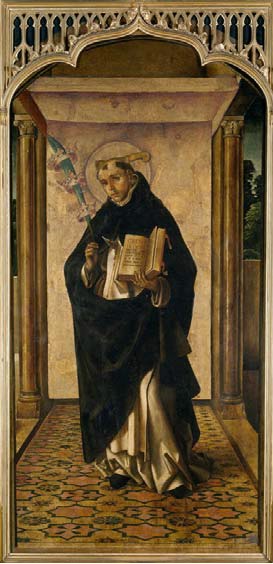LUCÍA GÓMEZ-CHACÓN, "San Pedro Mártir de Verona", Revista Digital de Iconografía Medieval, 11 (2014), pp. 79-96.
Resumen
San Pedro de Verona, protomártir de la Orden de Predicadores, cuyas reliquias se conservan en San Eustorgio de Milán, fue canonizado el 9 de marzo de 1253. Un año más tarde, en el capítulo general de 1254, se impulsó la presencia de representaciones del santo en todos los conventos dominicanos, promoviendo así su culto. Entre sus hermanos fue percibido como un perfecto paradigma de alter Christus al haber muerto en defensa de la fe, galardón que le había sido negado al propio fundador de la orden. Asimismo, al final de la Edad Media, durante el reinado de los Reyes Católicos, como patrón de los inquisidores por su incesante lucha contra la herejía, fue convertido, junto a santo Domingo de Guzmán, en un instrumento legitimador del Santo Oficio.
PALABRAS CLAVE: San Pedro Mártir; San Pedro de Verona; Orden de Predicadores; Orden mendicante; Dominicos; Inquisición; Imitatio Christi; Hagiografía
Abstract
Saint Peter of Verona, protomartyr of the Order of Preachers, whose relics are preserved in Sant"Eustorgio of Milan, was canonised on the 9th March 1253. One year later, the general chapter of 1254, encouraged the presence of representations of the saint in all Dominican convents as a way of promoting the saint"s cult. Among his brethren, Saint Peter of Verona was perceived as the perfect paradigm of the alter Christus for having died in defence of the Faith, award that had been denied to the founder of the order himself. Furthermore, in the Last Middle Ages, during the reign of the Catholic Kings, as patron of inquisitors for his constant fight against heresy, Saint Peter of Verona, alongside Saint Dominic of Guzman, was transformed into a legitimating instrument of the Holy Office.
KEYWORDS: Saint Peter Martyr; Saint Peter of Verona; Order of Preachers; Mendicant Order; Dominican Friars; Inquisition; Imitatio Christi; Hagiography

